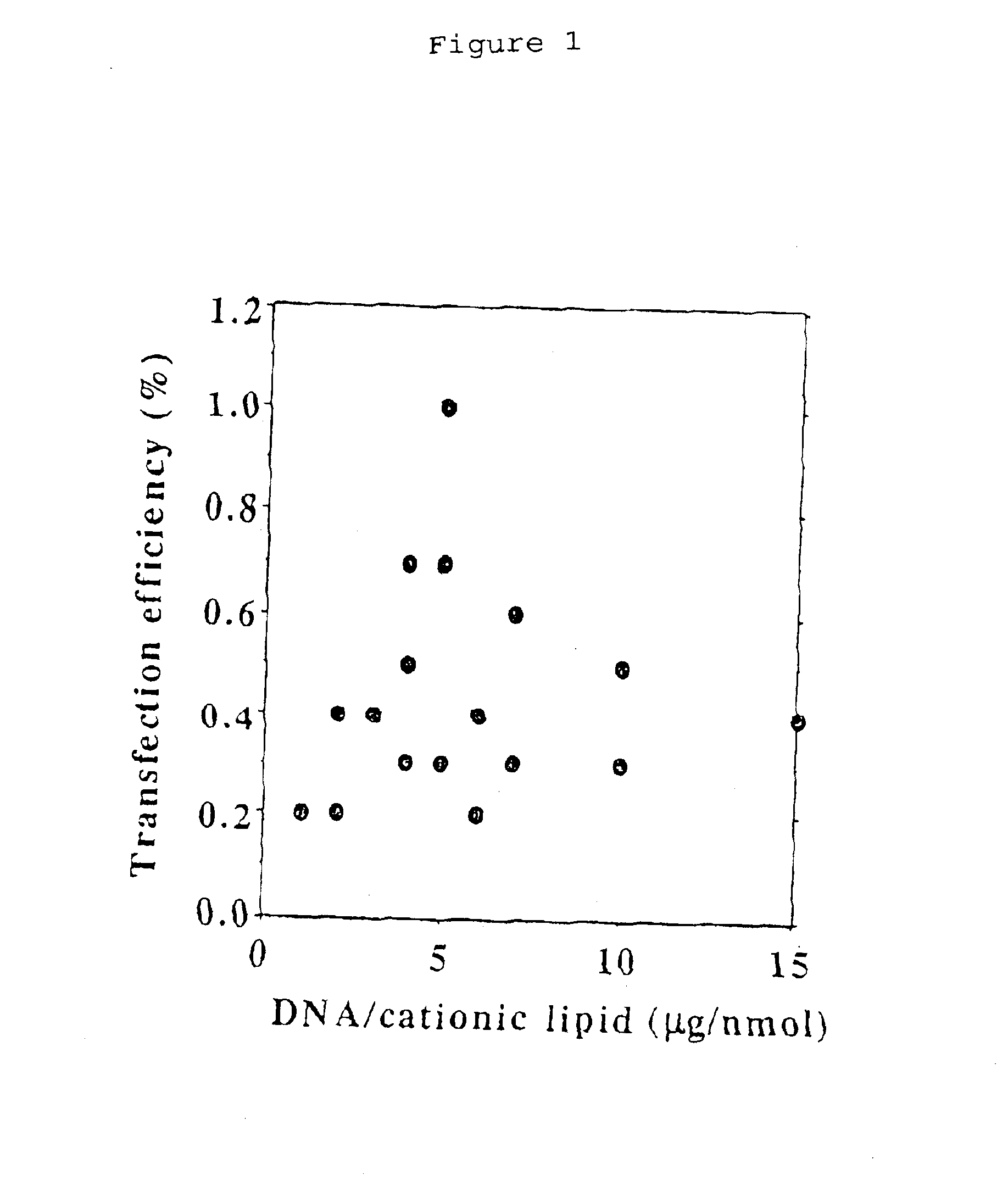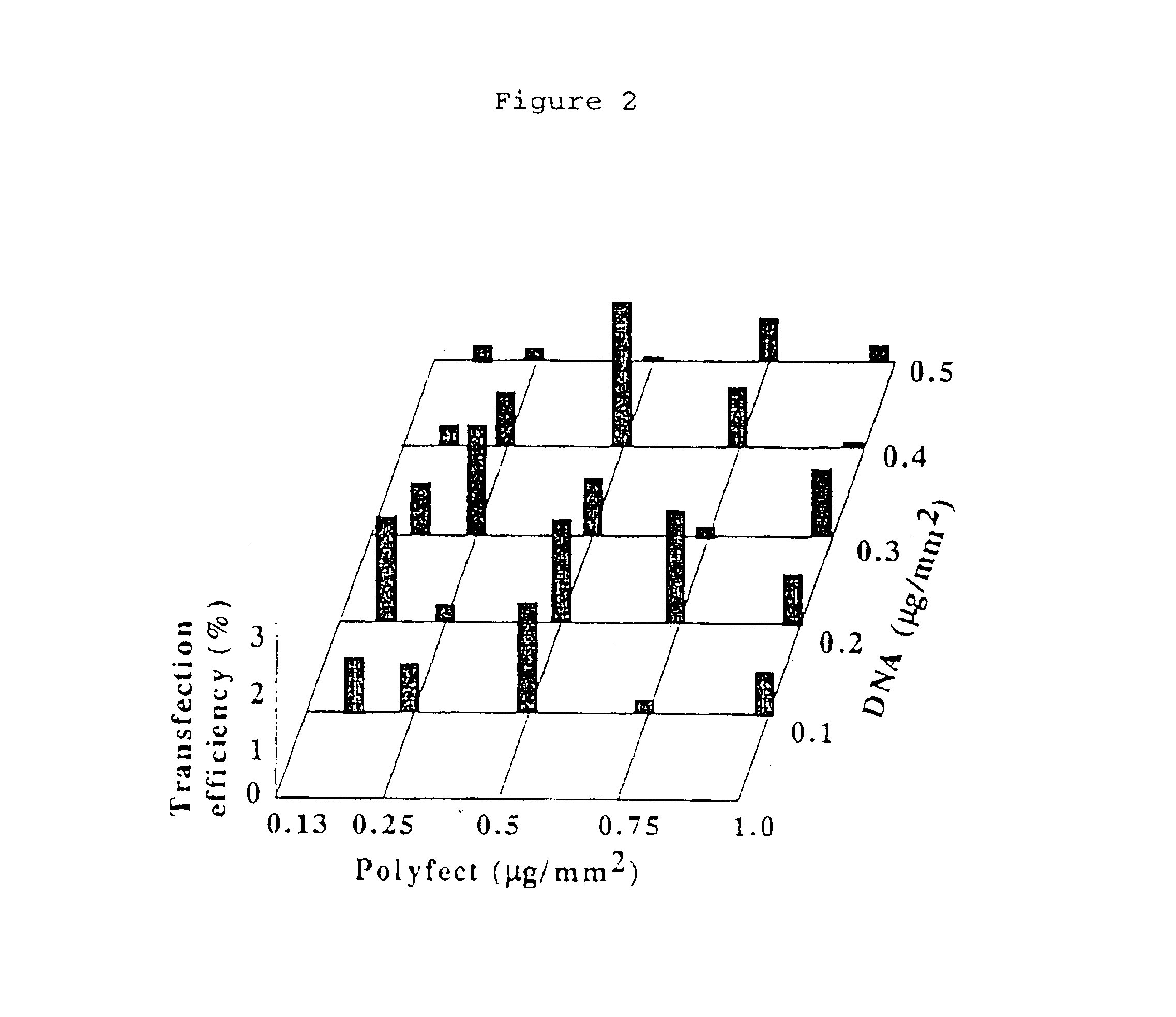DNA array for high throughput solid-phase transfection and method for producing the same
- Summary
- Abstract
- Description
- Claims
- Application Information
AI Technical Summary
Benefits of technology
Problems solved by technology
Method used
Image
Examples
example 1
[0061]The representative example of the transfection reagent is cationic lipids, which include Tfx™-20 (Promega, Madison, Wis., USA), and Effectene™ (QIAGEN, Valencia, Calif., USA). Both transfection reagents condense and wrap plasmid DNAs in cationic lipids. The complex of plasmid DNA and transfection reagent is fused with cell membrane and then plasmid DNA is entered inside cells.
[0062]The glass plate was prepared as follows: The glass slides (7 cm×2.5 cm) were marked with 80 squares (2 mm×2 mm) distincted by 1-mm Teflon line. The glass slides were treated by incubation for 1 hr in ammonium hydroxide solution (Aldrich, Milwaukee, Wis., USA) and washed with distilled water. Then, the glass plates were incubated in poly-L-Lysine solution (10% (v / v) poly-L-lysine solution (Sigma, St. Louis, Mo., USA) and 10% (v / v) phosphate buffered saline buffer) for 1 hr and washed with distilled water. The glass plates were air dried and stored in a desiccator until use.
[0063]Plasmid samples (pEGF...
example 2
[0068]PolyFect™ transfection reagent (QIAGEN Co.) is consisted of an active dendrimer molecules which is diverged from a center of the molecule and have positively charged amino groups at the branched termini to interact with phosphate groups of DNA. PolyFect™ reagent makes DNA to condense in compact form which is easily incorporated into cells by endocytosis.
[0069]DNA / PolyFect ratio in the DNA printing mixture (minus fibronectin) was investigated to obtain the highest transfection efficiency (FIG. 2). Inhibition of adherence and growth of HeLa cells was observed at concentrations of PolyFect in excess of 1.0 μg / mm2. At 0.5 μg / mm2 of PolyFect, relatively high transfection efficiency was observed using 0.1 to 0.4 μg / mm2 DNA. Larger or lower concentrations of PolyFect resulted in relatively low transfection efficiency probably due to the presence of excess charge on the surface and / or the non-optimal particle size of DNA / dendrimer complex for of HeLa cell transfection. The maximal tra...
example 3
[0071]The DNA printing and complex formation procedures for cationic lipid and dendrimer-mediated solid-phase transfection systems are different. In the cationic lipid-mediated solid-phase transfection procedure, DNA was printed first, then, the DNA / cationic lipid complex was formed on the solid glass support. The physical process of exposing DNA to cationic lipids most likely increased the chance of cross-contamination of DNA between adjacent grid locations.
[0072]On the contrary, in the case of the dendrimer-mediated solid-phase transfection, DNA / dendrimer complex is directly printed on the glass plates. This is a simpler process than the cationic lipid-mediated system and reduced the chance of cross-contamination. In fact, the average frequency of cross-contamination in the dendrimer-mediated system was lower than the cationic lipid-mediated system (Table 1). The results suggest that the dendrimer-mediated system is well-suited for high-throughput transfection system. The use of f...
PUM
| Property | Measurement | Unit |
|---|---|---|
| Adhesion strength | aaaaa | aaaaa |
Abstract
Description
Claims
Application Information
 Login to View More
Login to View More - R&D
- Intellectual Property
- Life Sciences
- Materials
- Tech Scout
- Unparalleled Data Quality
- Higher Quality Content
- 60% Fewer Hallucinations
Browse by: Latest US Patents, China's latest patents, Technical Efficacy Thesaurus, Application Domain, Technology Topic, Popular Technical Reports.
© 2025 PatSnap. All rights reserved.Legal|Privacy policy|Modern Slavery Act Transparency Statement|Sitemap|About US| Contact US: help@patsnap.com



